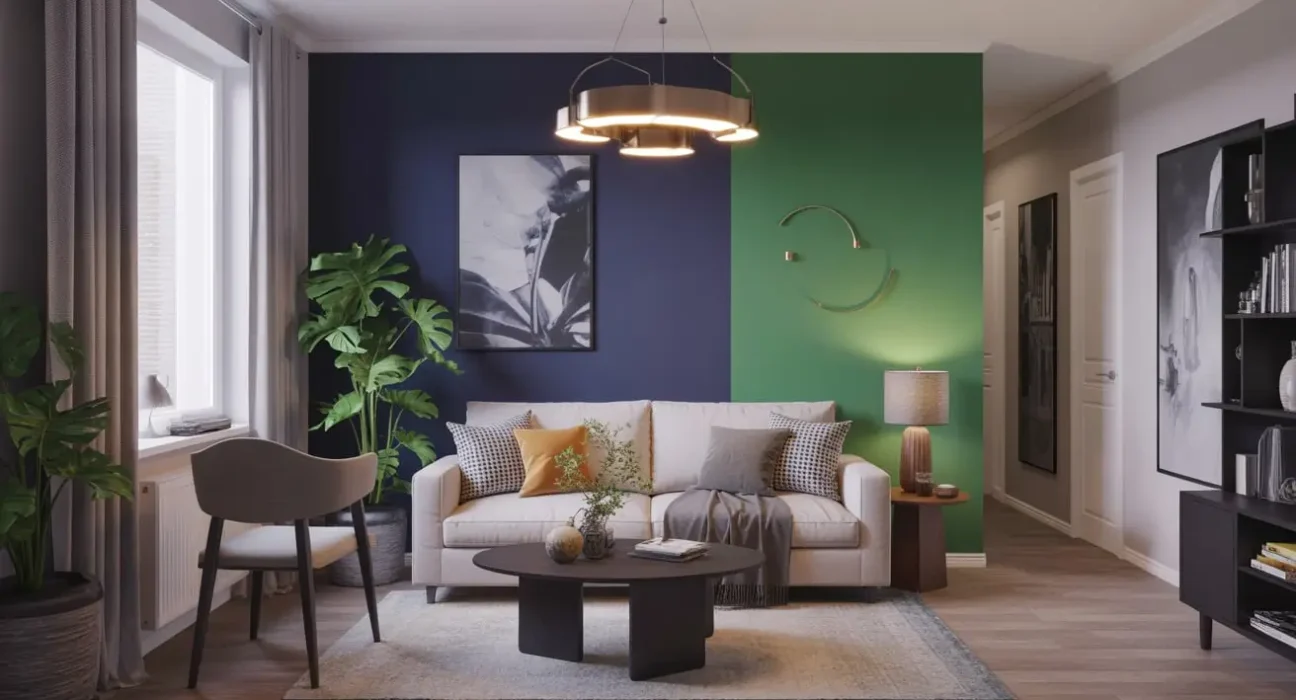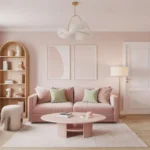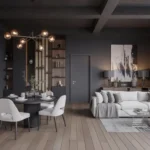Look, I get it. You’ve got a living room that’s roughly the size of a shoebox, and you’re trying to make it feel like an actual space where humans can, you know, live. The struggle is real, my friend. But here’s the thing—small living rooms aren’t a curse; they’re just a design challenge that requires some creativity and a willingness to think outside the cramped, tiny box.
I’ve been there. My first apartment had a living room so small that I genuinely considered whether my couch was too ambitious. Spoiler alert: it was. But over the years, I’ve figured out some tricks that actually work, and I’m about to share 15 brilliant ideas that’ll transform your miniature living space into something you’ll actually want to hang out in. No magic wands required, just smart choices and maybe a little furniture Tetris.
1. Minimalist Neutrals Living Room
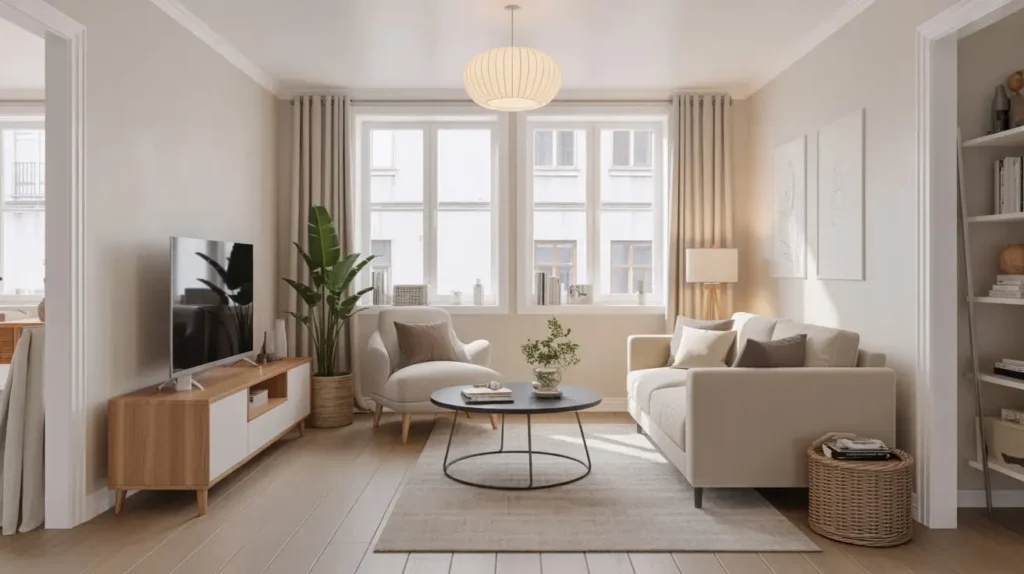
Ever notice how clutter makes small spaces feel even smaller? That’s where the minimalist neutrals approach swoops in to save the day. I’m talking about stripping things down to the essentials and embracing a palette that whispers rather than shouts.
Picture this: soft beiges, warm whites, gentle grays, and maybe a touch of cream. These colors don’t compete for attention, which means your eyes can rest instead of bouncing around like a pinball. When you use neutral tones throughout your small living room, you create visual continuity that tricks the brain into thinking the space is larger than it actually is.
Here’s what works in a minimalist neutral setup:
- A single comfortable sofa in a light neutral shade (think oatmeal or soft gray)
- Simple coffee table with clean lines—glass or light wood works beautifully
- Minimal accessories—one or two statement pieces instead of fifty random things
- Natural textures like linen, cotton, and jute to add warmth without color chaos
The beauty of this approach? It’s forgiving. When everything’s in the same color family, mismatched items don’t stick out like a sore thumb. I learned this the hard way when I tried to cram a bright red chair into my tiny living room. It looked like a fire truck had crashed into a library. Not cute.
Keep decorative items to a minimum. One gorgeous vase, a single piece of wall art, maybe a simple throw blanket. That’s it. Every item should earn its place in your limited square footage.
2. Multifunctional Furniture Setup
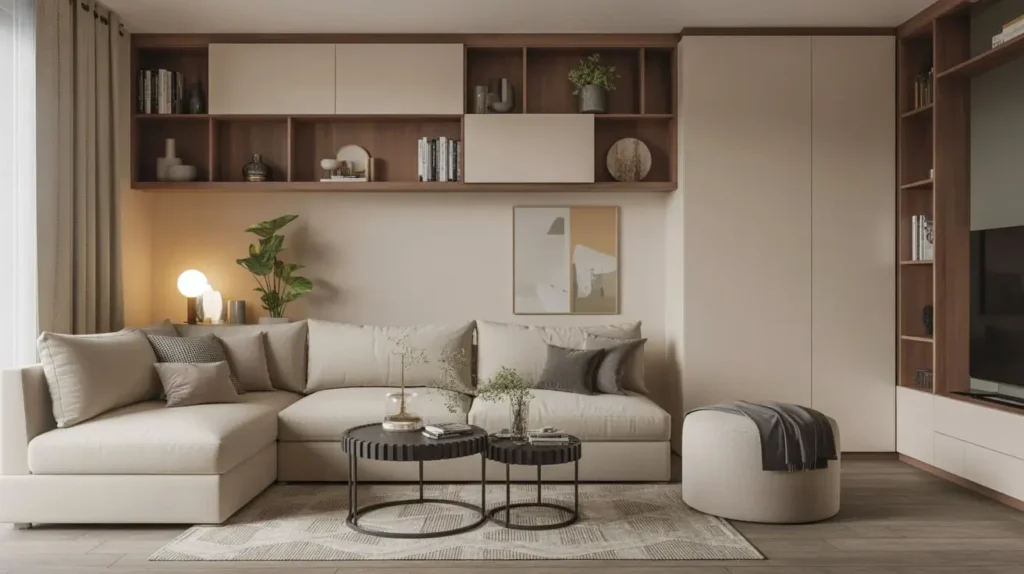
Can we talk about how multifunctional furniture is basically the Swiss Army knife of interior design? When you’re working with limited space, every piece needs to pull double (or triple) duty.
I used to think multifunctional furniture meant those weird futon-couch hybrids from college dorms. Wrong. The options now are actually stylish and genuinely useful. Furniture that serves multiple purposes is your secret weapon for making a small living room functional without feeling cluttered.
Check out these game-changers:
- Ottoman with storage inside—looks like regular seating, hides your mess
- Sofa bed—guest room? Who needs a whole room when your couch transforms?
- Nesting tables—pull them out when you need them, tuck them away when you don’t
- Storage benches—extra seating plus a place to stash blankets, books, whatever
- Wall-mounted drop-leaf table—folds down when you need a work surface or dining spot
My personal favorite? A coffee table that lifts up to become a dining or work surface. It’s like furniture origami, and it saved my sanity during work-from-home days when my “office” was also my living room, bedroom, and dining room. 🙂
The trick is choosing pieces that don’t look like they’re trying too hard. You want your living room to feel intentional, not like a Transformers convention.
3. Mirror Wall Illusion Design
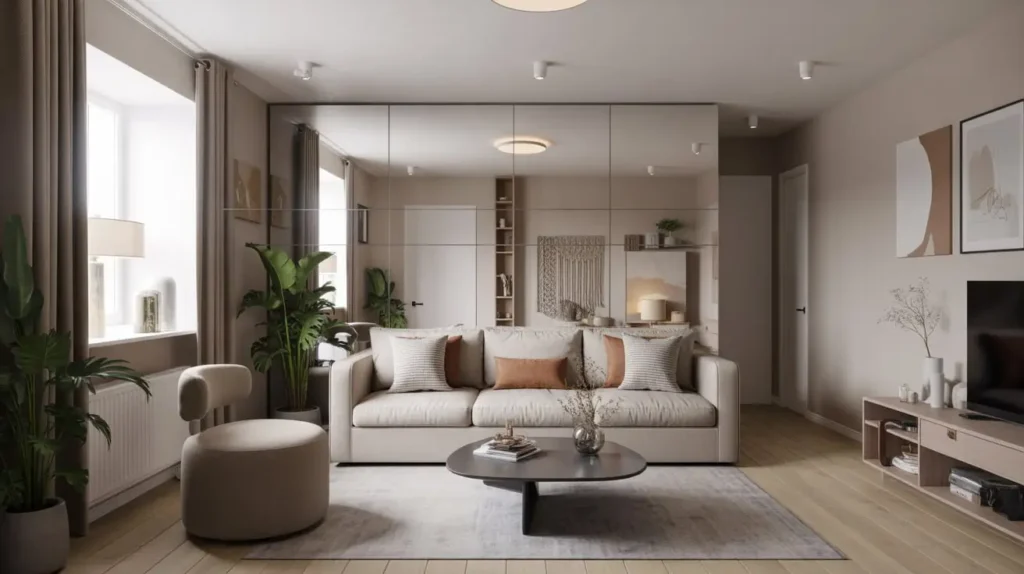
Okay, this one feels like actual magic. Mirrors are the optical illusion your small living room desperately needs. They bounce light around and create the perception of depth, which basically means your room looks bigger without you having to knock down any walls.
I’m not suggesting you turn your living room into a funhouse (unless that’s your vibe, no judgment). But strategically placed mirrors can genuinely double the visual space you’re working with. The key word here is “strategic.”
Here’s how to mirror like a pro:
- Place a large mirror opposite a window—this reflects natural light and the outdoor view, making your room feel more open
- Use mirrored furniture sparingly—a mirrored coffee table or console can add sparkle without overwhelming
- Try a mirror gallery wall—different sized mirrors clustered together create visual interest
- Go big or go home—one large statement mirror often works better than several small ones
I once put a floor-to-ceiling mirror on the narrowest wall in my living room, and honestly? Game changer. Suddenly my cramped space had what looked like a whole other room attached to it. Sure, I occasionally got confused about which direction I was actually looking, but the spatial illusion was worth the minor existential confusion.
Just avoid placing mirrors where they’ll reflect clutter or unflattering angles. Trust me on this one.
4. Light and Airy Scandinavian Space
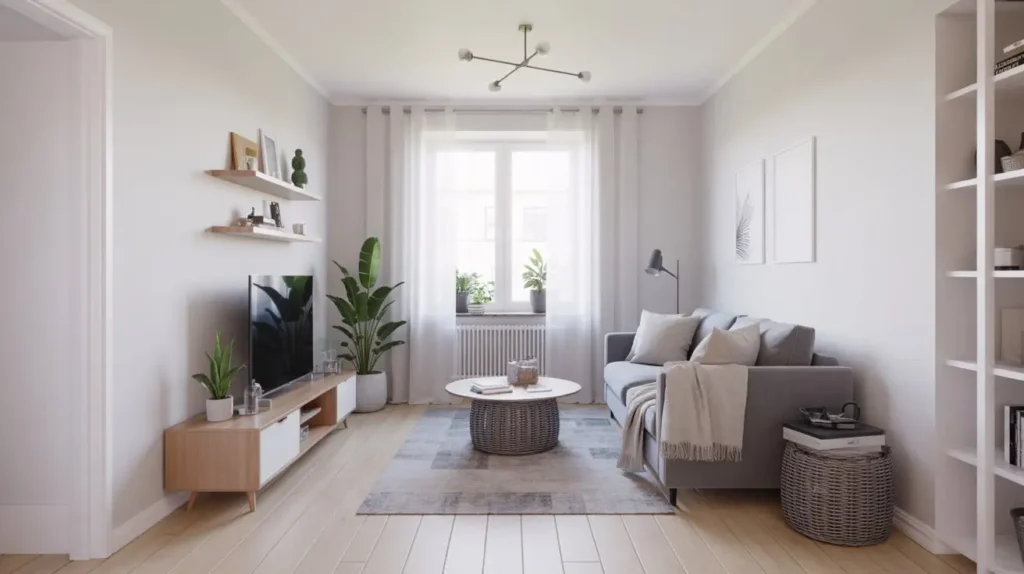
There’s a reason Scandinavian design took over Pinterest and never left. Those folks know how to make small spaces feel breathable, and they’ve been doing it way longer than the rest of us have been stress-scrolling through home decor accounts.
The Scandinavian approach to small living rooms focuses on light, simplicity, and functionality. We’re talking whites, light woods, clean lines, and just enough cozy texture to keep things from feeling sterile. It’s minimalism’s friendlier cousin.
Key elements of Scandinavian small living room design:
- White or light gray walls—reflect light and create an airy foundation
- Light wood furniture—think birch, pine, or light oak
- Plenty of natural light—keep window treatments minimal or sheer
- Cozy textiles—sheepskin rugs, knit throws, linen cushions
- Indoor plants—greenery adds life without visual weight
- Simple, functional pieces—nothing purely decorative that doesn’t serve a purpose
What I love about this style is that it feels both minimal and warm. You’re not living in a cold, empty box; you’re living in a thoughtfully curated space that happens to have really good vibes. The Scandinavians call it “hygge,” and frankly, they’re onto something.
Pro tip: Add warm lighting through multiple sources rather than one harsh overhead light. Table lamps, floor lamps, maybe some string lights if you’re feeling it. Layered lighting makes any small space feel more welcoming.
Also Read: 15 Cozy Living Room Decor Ideas for a Warm Ambiance
5. Vertical Storage Smart Shelving

When you can’t go out, go up. Seriously, why do so many people ignore their walls when floor space is at a premium? Vertical storage is the move you need to make, like, yesterday.
I used to be one of those people who left walls blank because I thought it made rooms feel bigger. Plot twist: it just made my floors cluttered because I had nowhere to put my stuff. Once I started thinking vertically, everything changed.
Smart vertical storage options:
- Floor-to-ceiling shelving units—use the full height of your room
- Floating shelves—display books, plants, and decorative items without bulky furniture
- Wall-mounted cabinets—storage that doesn’t eat up floor space
- Ladder shelves—lean against the wall and provide multiple levels of storage
- Pegboards or rail systems—customizable and actually pretty cool looking
The trick is making your vertical storage look intentional rather than desperate. Group items by color or size, leave some breathing room, and don’t cram every shelf full. Curated vertical storage looks sophisticated; overstuffed vertical storage looks like you’re preparing for the apocalypse.
I installed floating shelves above my sofa, and not only did I gain storage space, but the vertical lines actually made my low ceiling feel higher. Who knew physics could be decorative?
6. Compact Sectional Layout

Here’s a controversial take: sectionals aren’t just for big living rooms. A compact sectional can actually work beautifully in a small space if you choose the right size and configuration. The key is “compact”—we’re not talking about those massive L-shaped beasts that could seat a football team.
Small-scale sectionals give you maximum seating in a minimal footprint. They fit snugly into corners, defining your seating area without requiring additional chairs that would clutter up the space. Plus, they just feel cozy, which is exactly the vibe you want in a small living room.
What to look for in a small-space sectional:
- Low profile and streamlined design—no bulky arms or excessive cushioning
- Light-colored upholstery—keeps things feeling airy
- Modular pieces—so you can reconfigure if needed
- Raised legs—shows more floor, makes the room feel bigger
- Right size for your space—measure twice, buy once (seriously)
I made the mistake of buying a sectional that was technically small but had these huge, puffy arms that ate up precious inches. Those inches matter, people! Now I look for slim arms and clean lines, and my current compact sectional fits perfectly without overwhelming the room.
Position your sectional in a corner to maximize the rest of your floor space. This creates a defined conversation area while leaving room for traffic flow.
7. Cozy Boho Small Living Room

Not everyone wants minimalist neutrals (though they’re great, as we established). Some of us want color, texture, pattern, and that collected-over-time vibe. Enter the boho aesthetic, which is surprisingly workable in small spaces if you do it thoughtfully.
The boho look is all about layering textures, mixing patterns, and creating a warm, eclectic space that feels personal. In a small living room, you just need to be a bit more selective about what you layer and where.
Boho elements that work in small spaces:
- Textured throw pillows and blankets—add visual interest without taking up space
- Macramé wall hangings—vertical decoration that adds bohemian flair
- Rattan or wicker furniture—lightweight and on-trend
- Layered rugs—yes, even in small rooms; it creates cozy zones
- Plants, plants, and more plants—trailing pothos, hanging planters, small succulents
- Warm, earthy color palette—terracotta, mustard, sage green, warm neutrals
The secret to boho in a small space? Edit ruthlessly. You want that curated, collected look, not the “I ransacked a flea market” chaos. Every pattern and texture should complement the others rather than compete.
I’ve got a tiny boho living room corner with a rattan chair, some macramé, and about seven plants, and honestly? It’s my favorite spot in the entire apartment. The textures make it feel cozy without being cluttered, and the plants make me feel like I have my life together (even though I definitely don’t).
8. Monochrome Minimalist Look
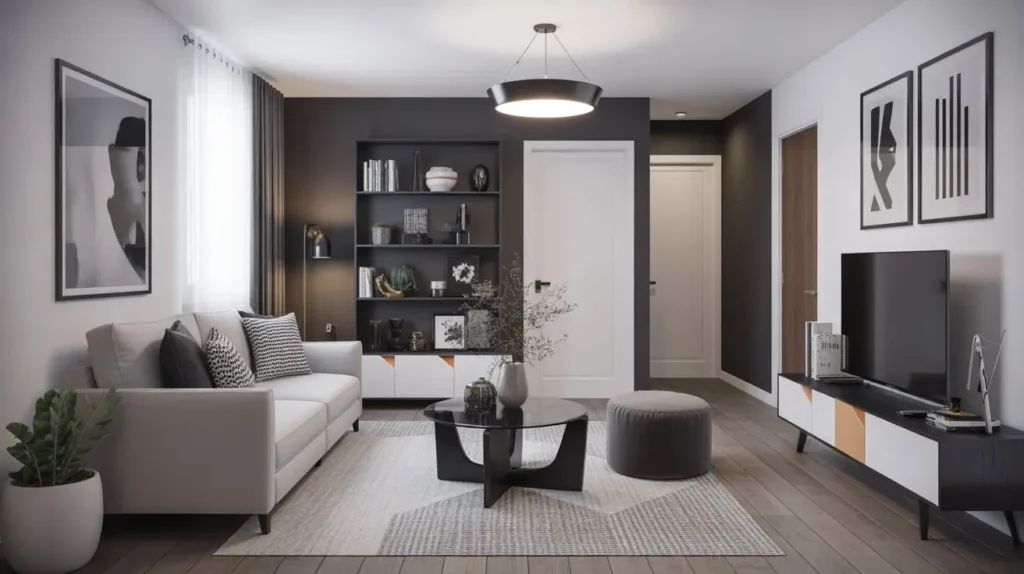
If neutrals are too wishy-washy for you, try going full monochrome. Pick one color—black and white is classic, but you could do all navy, all gray, all blush pink if that’s your thing—and commit to it completely.
Monochrome design creates a cohesive, intentional look that makes small spaces feel sophisticated and well thought out. There’s something powerful about a room that’s unapologetically committed to a single color story.
How to nail the monochrome look:
- Choose your base color—this will dominate walls, large furniture pieces
- Use varying shades—light to dark creates depth and interest
- Mix textures like crazy—this is crucial to avoid a flat, boring look
- Add one metallic accent—brass, gold, chrome, or copper as a subtle contrast
- Incorporate different materials—velvet, leather, wood, metal, all in your chosen color
The most successful monochrome small living room I ever designed (for myself, but still) was entirely in shades of gray. Charcoal sofa, light gray walls, medium gray curtains, dark gray accent pillows, and silvery metallic accents. FYI, people genuinely thought I hired a designer. I did not. I just committed to the bit.
Texture is everything in monochrome spaces. Without it, your room looks like a paint swatch explosion. With it, you get sophistication and visual interest despite the limited color range.
9. Floating Furniture Arrangement

This concept blew my mind when I first tried it. Instead of pushing all your furniture against the walls (which seems logical in a small space), try floating your furniture slightly away from the walls. I know, it sounds counterintuitive, but hear me out.
When you pull furniture a few inches away from the walls, you create the illusion of more space. It allows air to circulate visually around the pieces, making your room feel less cramped. Plus, it just looks more intentional and designed.
Tips for floating furniture in small living rooms:
- Pull your sofa 6-12 inches from the wall—creates breathing room
- Float a console table behind the sofa—adds function and visual depth
- Position chairs at slight angles—more dynamic than everything squared off
- Leave walking space around furniture—at least 18-24 inches for pathways
- Use area rugs to define zones—grounds the floating furniture
I was skeptical about this one until I tried it. I pulled my sofa away from the wall, added a narrow console table behind it, and suddenly my cramped living room had layers and dimension. Did I lose a few inches of floor space? Technically. Did it feel bigger anyway? Absolutely. Sometimes design is about perception, not reality.
Just don’t float furniture so far that you can’t actually walk around it. That’s just creating obstacles, not design. :/
10. Foldable Furniture Magic
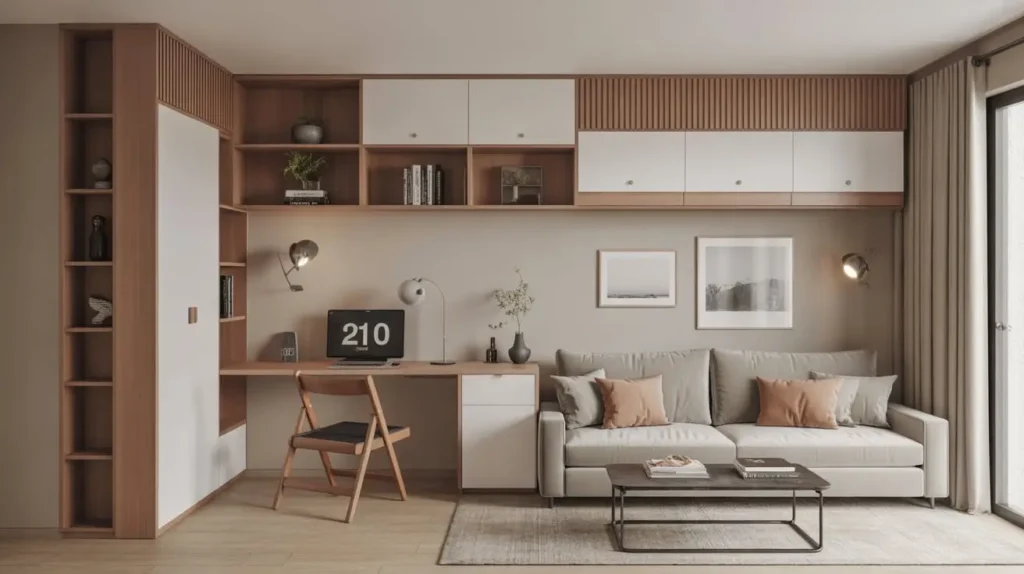
Let’s talk about furniture that disappears when you don’t need it. Foldable and collapsible furniture is clutch for small living rooms where flexibility is everything. You need seating for guests? Pull it out. You need floor space for yoga or dancing or whatever? Fold it up and tuck it away.
I used to think foldable furniture was just for camping, but the options available now are actually stylish and sturdy. We’ve come a long way from those wobbly card tables, thank goodness.
Foldable furniture worth considering:
- Folding chairs—store flat in a closet, bring out for guests
- Collapsible side tables—appear when needed for drinks or snacks
- Murphy bed/desk combos—if your living room is also your bedroom/office
- Folding TV trays—yes, they still exist, and some are actually chic now
- Pop-up coffee tables—adjust height or fold completely flat
My secret weapon is a set of acrylic folding chairs that look surprisingly modern and store in my coat closet when I’m not hosting. They’ve saved me more times than I can count when I have more guests than seats.
The beauty of foldable furniture is the flexibility it provides. Your small living room can transform based on what you’re doing, which is basically the dream, right?
Also Read: 15 Dreamy Green Kitchen Ideas for a Modern Makeover
11. Corner Sofa and Floating TV Wall
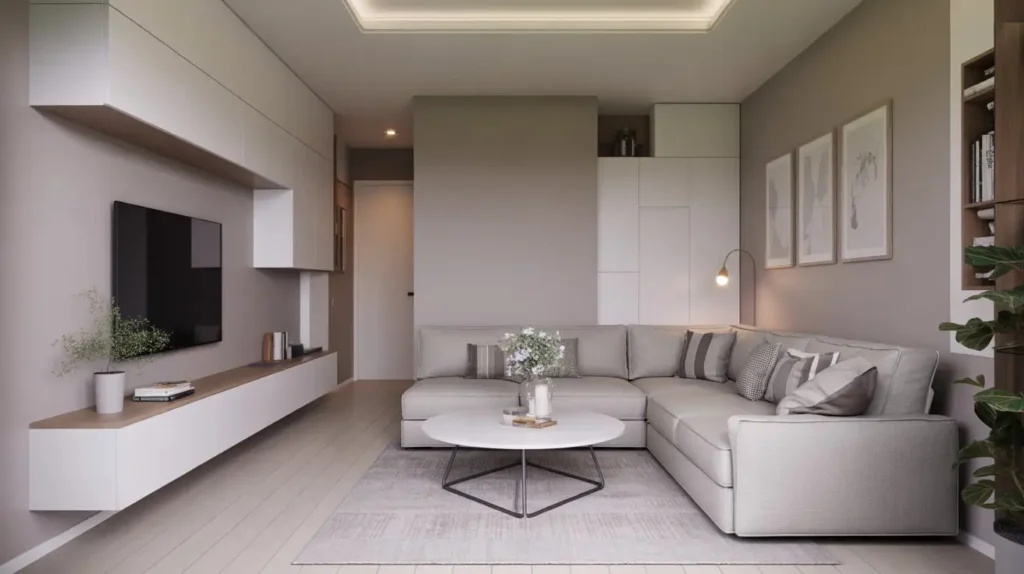
Corners are the most underutilized real estate in small living rooms. A corner sofa paired with a floating TV wall unit maximizes your space in a way that’s both functional and visually streamlined.
By tucking your sofa into the corner, you free up the rest of the room for other functions. And a floating TV unit keeps things feeling light and modern while providing essential storage without bulky furniture.
How to execute this layout:
- Choose a corner sofa that fits your exact space—measure carefully
- Mount your TV on the wall—frees up floor space completely
- Install floating shelves or a floating console below the TV—for media equipment and storage
- Keep the wall unit simple and streamlined—no massive entertainment centers
- Use the opposite corner for a plant or reading lamp—balances the room
This setup creates a defined entertainment zone without dedicating your entire small living room to TV-watching. I’m a fan of wall-mounted everything in small spaces because it shows more floor, which psychologically makes the room feel larger.
Plus, you can store stuff in the floating console (remotes, cables, all that random tech junk) and keep your space looking clean. Hidden storage is basically magic in small living rooms.
12. Soft Pastel Small Space Decor
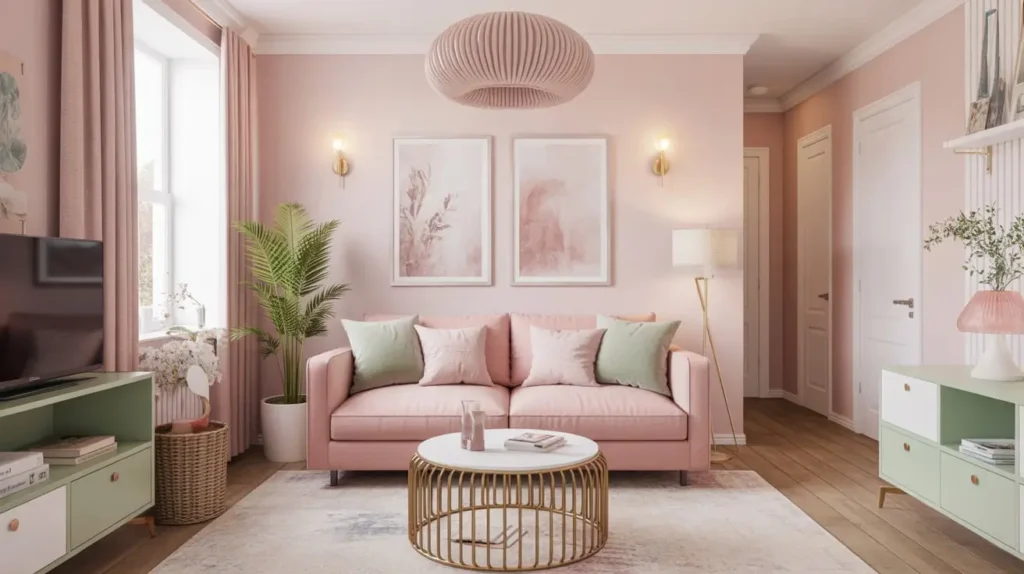
Who says small spaces need to be all white and neutral? If pastels make your heart happy, then soft pastel decor can absolutely work in a tiny living room. We’re talking blush pink, soft mint, pale lavender, powder blue—colors that have personality without being aggressive.
Pastels feel fresh, airy, and young without the starkness of all-white spaces. They add character and warmth while still maintaining that light, spacious feeling you need in a small room.
Creating a pastel small living room:
- Pick one or two pastel shades as your primaries—too many gets chaotic
- Use white or cream as your base—keeps things from feeling like a candy store
- Add metallic accents—gold or rose gold looks gorgeous with pastels
- Incorporate natural materials—wood, rattan, linen balance the sweetness
- Keep patterns simple—florals, geometric shapes, nothing too busy
I experimented with a blush and sage color scheme in my small living room, and honestly, it felt like living inside a spring day. The soft colors reflected light beautifully, and the space felt feminine without being overly precious or childish.
Pastels work best when balanced with neutrals and natural textures. Otherwise, you risk looking like you’re living in a dollhouse (unless that’s your goal, in which case, you do you).
13. Hidden Storage Coffee Table Style
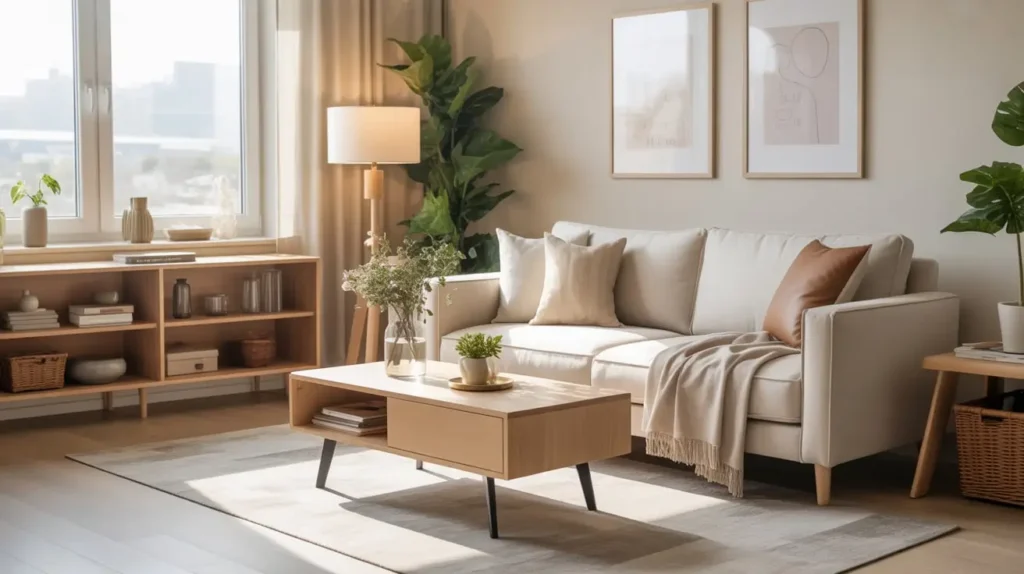
Can we appreciate how much random stuff we accumulate in living rooms? Remotes, magazines, coasters, charging cables, that random thing you meant to put away three weeks ago—it adds up. A coffee table with hidden storage solves this problem while looking completely normal.
Hidden storage is the unsung hero of small living room organization. It keeps your surfaces clear while still giving you a place to stash all the things you actually use regularly.
Hidden storage coffee table options:
- Lift-top coffee tables—the top lifts to reveal storage inside
- Ottoman coffee tables—soft top for feet, storage underneath
- Coffee tables with drawers—obvious but effective
- Trunk-style coffee tables—vintage vibes plus tons of storage
- Shelf underneath—not exactly hidden, but adds storage levels
My current coffee table has a lift-top that reveals storage I use for throw blankets, books, and all my random remote controls. From the outside, it looks like a normal coffee table. Open it up, and it’s basically a clutter containment system. Honestly? It’s one of my better adult decisions.
The less clutter you see, the bigger your small living room feels. Hidden storage lets you have your stuff without your stuff having visual dominance over your space.
14. Bold Accent Wall in Tiny Spaces
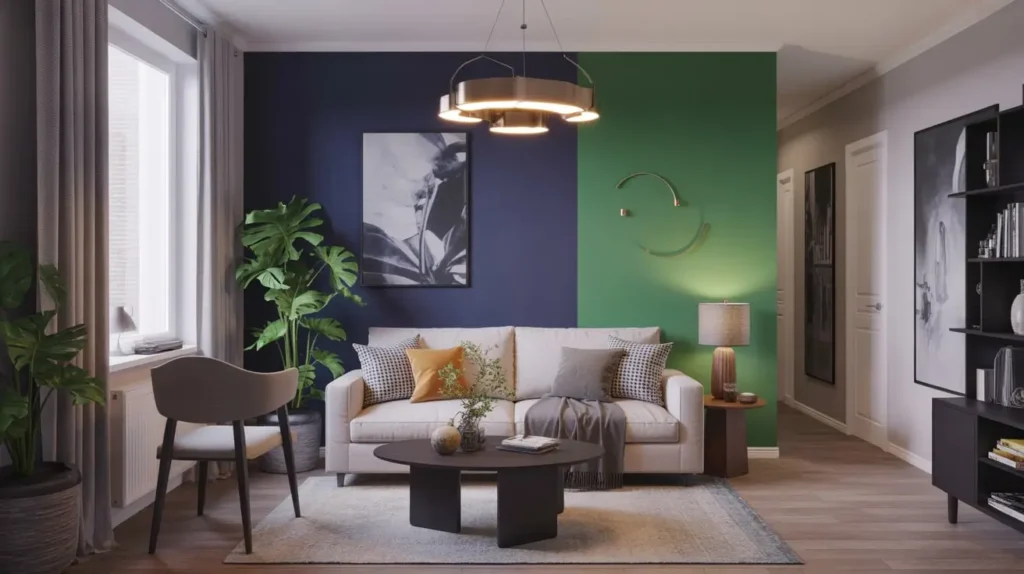
Here’s where I’m going to tell you something that might surprise you: bold accent walls can work in small living rooms. I know, I know—conventional wisdom says light colors make small spaces feel bigger. And that’s true! But sometimes you want personality and drama, and a bold accent wall delivers exactly that.
The trick is using that bold color strategically. One accent wall adds depth and interest; four bold walls will make your small space feel like a cave. IMO, this is where you can take a risk and actually make your tiny living room memorable.
How to do bold accent walls right:
- Choose the wall that makes the most visual sense—often the wall behind the sofa or the wall you see when entering
- Keep the other walls neutral—this creates contrast and prevents overwhelm
- Go bold with color or pattern—deep navy, emerald green, or even wallpaper
- Balance with light furniture and accessories—don’t add more visual weight
- Use good lighting—dark walls need proper illumination
I painted one wall in my small living room a deep charcoal blue, and people always comment on it. It creates a focal point that draws the eye, and somehow it makes the room feel more spacious rather than less. The contrast between the bold wall and the light walls creates dimension.
Don’t be afraid of color. Just be strategic about where and how much you use.
15. Open-Concept Small Living Area
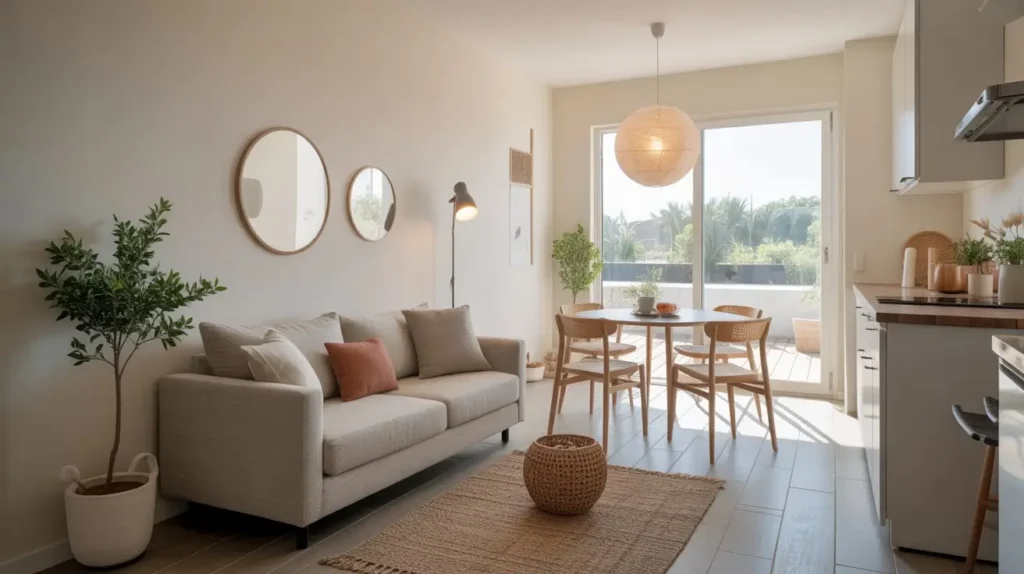
If you have the option—and I realize not everyone does—an open-concept layout can make a small living room feel significantly larger by connecting it visually to adjacent spaces. Knocking down a wall (where structurally possible) between your living room and kitchen or dining area creates flow and visual continuity.
Open-concept doesn’t necessarily mean full renovation, though. Sometimes it’s just about sightlines and furniture arrangement that doesn’t block the view between spaces.
Creating open-concept flow:
- Remove unnecessary visual barriers—bulky furniture that blocks views
- Use consistent flooring—helps spaces flow into each other
- Maintain a cohesive color palette—across connected spaces
- Define zones with area rugs—instead of walls
- Keep window treatments minimal—maximize light flow between areas
My apartment has a semi-open living and dining area, and honestly, it makes both spaces feel larger. I can see from the living room into the kitchen, which creates a sense of depth and spaciousness that wouldn’t exist if there were walls everywhere.
Even if you can’t physically change your layout, arranging furniture to create visual pathways between spaces can create a more open feeling. The goal is flow, not barriers.
Look, transforming a very small living room into something you actually love isn’t about having a massive budget or knocking down walls (though that can help). It’s about making smart, strategic choices with furniture, color, and layout. Every single one of these 15 ideas works—I’ve tried most of them myself in various apartments and spaces over the years.
The reality? Your small living room has potential you probably haven’t tapped into yet. Whether you go full minimalist with neutrals, embrace maximalist boho vibes, or land somewhere in between with pastels and patterns, the key is being intentional about every choice. Small spaces don’t give you room for random decisions or impulse buys that don’t fit.
Start with one or two ideas that resonate with you and your lifestyle. You don’t need to implement all 15 (that would be chaotic anyway). Maybe you start with some vertical storage and a hidden storage coffee table. Or perhaps you paint an accent wall and add some mirrors. Small changes can make a surprisingly big difference.
Your tiny living room isn’t a limitation—it’s an opportunity to get creative, edit ruthlessly, and create a space that’s uniquely yours. And honestly? Some of the coziest, most welcoming living rooms I’ve ever been in were the smallest. There’s something intimate and intentional about a well-designed small space that you just don’t get in cavernous rooms.



